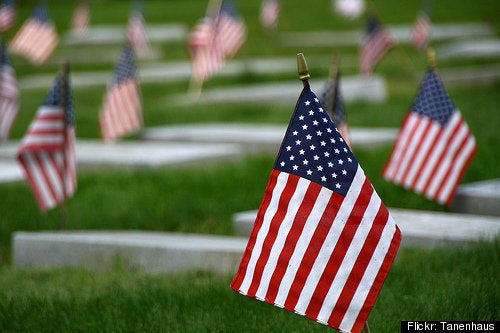
Okay, it is official. "Summer" is here. A few days ago, I saw the first article promising higher prices at the pump for Memorial Day. The traditional kickoff to the summer season always brings front-page stories about travel costs, traffic snarls, picnic tips, and what to wear at the beach. Can a bathing suit sale be far off?
But this Memorial Day comes with darker news-- the announcement that the United States military had surpassed more than 1,000 service members killed in Afghanistan, a war begun October 7, 2001 following the 9/11 attacks.
The combat deaths in Afghanistan, which have accelerated recently with a "surge" of US troops in the troubled nation once ruled by the Taliban, goes along with the 4,401 Americans who have died in Iraq (Source: DoD, 5/18/10) since the invasion there began on March 20, 2003.
These black and white numbers don't tell the true story behind the casualty figures. Every one of those numbers stands for an individual -- a son, a sister, a mother, a brother, a father. But the stark numbers do remind us that Memorial Day is ultimately a day about loss.
Memorial Day has its roots in the Civil War -- the nation's bloodiest conflict with more than 600,000 dead and countless more wounded and maimed. Memorial Day began with the simple act of placing fresh flowers on the graves of fallen soldiers. In other words, "decorating" the graves, which gave rise to a national holiday of commemoration called Decoration Day. Once traditionally celebrated on May 30, it was a date chosen because the most flowers were in bloom in the North. But many states in the former Confederacy, viewed this as a "northern" holiday and created their own Confederate Memorial Days.
Given a semi-official launch in 1868 by the Grand Army of the Republic, a politically powerful fraternal organization, the holiday grew over the years, only to be forgotten in the early 20th century as the Civil War generation died off. It was given fresh urgency in the wake of World War I and the tremendous losses in the trenches of Europe. It was after that conflict that America began to recognize a need for reviving a holiday that honored the sacrifice of those who died in all of America's wars, not just the Civil War. Memorial Day, as it eventually became known, was made a national holiday and was fixed on the last Monday in May date by a 1968 act of Congress that took effect in 1971. (Some traditionalists want to restore the original May 30 date.)
Memorial Day's history and meaning have been obscured for many Americans. And as the holiday weekend approaches, the wars in Iraq and Afghanistan also seem mostly hidden from view. A numerical landmark such as the 1000th death or an act of Taliban terror such as a suicide bombing in the capital of Kabul, puts the war back on the front pages for a day or so. The fighting in Iraq, where US troop numbers are slowly being drawn down, is even more hidden.
Which brings me to some of America's hidden wars. Most of us are well schooled about World War II, which gets most of the glory, with lavish HBO productions like The Pacific. And the Civil War still occupies a central -- if still overly "mythified" place -- in America's consciousness.
But there are many wars from the past that have fallen into the black hole we call "American History." Most of us, for instance, have never heard of the "Creek War," a vicious conflict fought in Alabama between Creek Indians and American troops led by a relatively unknown Tennessee planter named Andrew Jackson. Jackson's ruthless victory over the Creek, led by a half-Scot, half-Creek warrior named William Weatherford, or Red Eagle, helped established Jackson's heroic reputation. His ruthlessness in dealing with the Indians helped establish his nickname as "Sharp Knife." The Creek War, a complicated struggle over land and freedom, took place even as America was fighting against England during the War of 1812.
The warfare between the federal government and Native American nations and their African-American allies continued in Florida in the long, costly series of wars called the Seminole Wars. Fought between 1835 and 1842, the Second Seminole War was America's longest war between the Revolution and Vietnam, as the Seminoles, led by their war chief Osceola, kept American armies at bay for years in an an expensive, deadly guerrilla war.
No wars -- or the losses and sacrifice they demanded -- should be forgotten or overlooked, especially as we approach Memorial Day. This year, let's remember all the fallen and forgotten fighters.